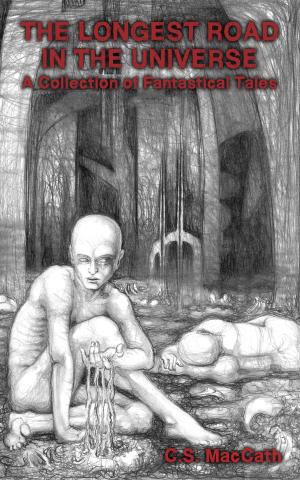Genetically-altered residents of a volcanic desert are left to suffer and die as nanomachines terraform the world around them in "N is for Nanomachine." Available in A is for Apocalypse.

A is for Apocalypse
MacCath, C.S. 2014. "N Is for Nanomachine." In A Is for Apocalypse, edited by Rhonda Parrish, 109–26. Edmonton: Poise and Pen.

The Longest Road in the Universe: A Collection of Fantastical Tales
MacCath, C. S. 2016. "N Is for Nanomachine/For Want of an Ash Fall." In The Longest Road in the Universe: A Collection of Fantastical Tales, First Edition, 108–27. South Haven: Triskele Media Press.

The Longest Road in the Universe: A Collection of Fantastical Tales
MacCath, C. S. 2020. "N Is for Nanomachine/For Want of an Ash Fall." In The Longest Road in the Universe: A Collection of Fantastical Tales, Second Edition, 89–104. South Haven: Triskele Media Press.
Reviewer's Note: As a member of the Washington Science Fiction Association, I may vote on the WSFA Small Press Award. Voting closed on July 31st, and my votes are locked in. Although the stories are identified by author here, they are presented to members of WSFA anonymously, so all of the members vote based solely on the text of the story, as uninfluenced by the identities of the authors as possible. Nine stories were nominated this year, and although I ranked them one through nine, I will note that every story here was better than every story in the short fiction categories in the 2015 Hugo Awards. If any one of these stories had appeared on the Hugo ballot this year, it would have been my first place vote.
A story about the death of a people, N Is for Nanomachine confronts the question of what happens when a civilization knows it is going to die and there is simply nothing they can do about it. Set on the planet Vardigen, originally a prison colony populated by humans altered to live on its harsh, volcanic surface, the story details the last days of its inhabitants as nanomachines inexorably change the landscape they depend upon to live into a terraformed Earth-like world suitable for settlement by "organics". Unfortunately, this terraforming will inevitably kill those currently living on Vardigen, condemning them to slow, painful deaths from what amounts to poison and starvation. The Vardigen response is to preserve their art and culture: Opera, sculpture, poetry, and painting and store it so that those who come later will know exactly who they destroyed. Told in the form of a series of voice mails, e-mail messages, and news broadcasts, the story follows one of the hundred couriers sent across the planet to collect artwork from masters of their craft, giving a brief window into how each one reacts to the looming disaster: One with despair, another with anger, another with defiance, and finally, one with love. As the populace faces their extinction, they also react with inchoate rage, with resigned acceptance, with doomed but heroic schemes. The role reversal in the story, with terraforming the planet to make it habitable for normal humans being the harbinger of death, makes it all the more interesting, as does the fact that the rest of humanity seems entirely indifferent to the suffering of the Vardigen denizens, placing the reader into the ranks of the silent villains of the piece. N Is for Nanomachine could have been nihilistic and depressing, but it is instead stirring and almost lovely, as a dying people find meaning amidst the wreckage of their world.
~ Dreaming About Other Worlds (A WSFA Member Blog)
...The uses of the apocalypse are wildly varied, which brings some unexpected flavours to the collection. Two well constructed ends of the spectrum come from ‘Q is for Queen’ (Brittany Warman) and ‘N is for Nanomachine’ (C.S. MacCath). The former is one of the shortest pieces in the book, but is one of the most considered. Following a handful of dishevelled worshippers of a mystic queen, the story perfectly sets up the few minutes right before the world is plunged into a blood and hellfire fantasy end. The latter, is a science fiction take on the genre. A planet of synthetic people (it would be reductive to use ‘beings’) face an inevitable extinction at the hands of the human race, who created them in the first place. It is told from the perspective of a scientist, a painter (who together are a couple), a poet, a composer and the head of state. Through letters from each of these characters you are given access to the beautiful aspects of life, which makes the inescapable climax all the more unbearable.
~ Sabotage Reviews
Nominated for the Pushcart Prize.
Shortlisted for the WSFA Small Press Award.